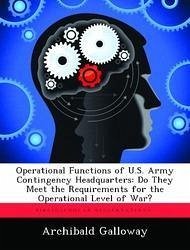As the U.S. Army continues to refine its operational doctrine, the performance of higher headquarters in meeting the requirements of that doctrine becomes a critical factor in the successful prosecution of modern war. This study examines the operational functions of U.S. Army higher headquarters and their failure to keep pace with the dynamic doctrinal requirements created by FM 100-5, Operations, and the changing nature of the battlefield. Most significant, it analyzes requirements for higher headquarters, the functions headquarters should perform, operational characteristics of historical U.S. headquarters, and the changes needed in two current contingency headquarters. The study concludes that U.S. Army contingency headquarters currently fall short of fully satisfying either the requirements or a process for the adequate prosecution of the operational level of war. However, the conclusions drawn from this investigation suggest that the problem is correctable provided: (1) Higher headquarters define the aim for the entire operational side of the war and determine the series of actions intended to achieve it. (2) Operational headquarters develop an operational process immersed in "education and thinking." Performance measurement of this process is achieved by analyzing the operational functions of responsiveness, effectiveness, and efficiency within the headquarters. (3) In order to align themselves with current doctrine and the battlefield, contingency headquarters should press for the development of echelon above corps doctrine, significant changes in headquarters resourcing, and the elimination of the requirement to dual-hat commanders between logistical and operational functions. The ultimate purpose of the operational level headquarters is to structure efficiently, effectively, and responsively the operational level of war so that engagements, battles, and campaigns achieve strategic significance. This study supports the proposition that contingency headquart








